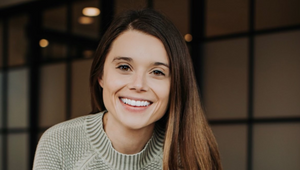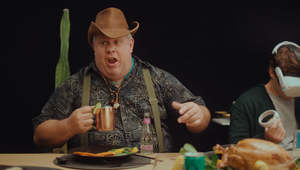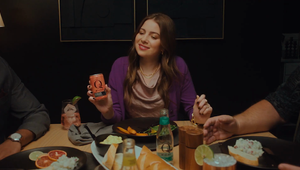
UPBrand’s Rachel Geringer on the Production Technology “Ecosystem” That Captures the Perfect Shot

Nashville-based production company Gear Seven pushes the limits of creativity, technology and possibility - and innovates like it’s nobody's business. Alongside a non-exclusive roster of directors and production capabilities, Gear Seven offers hardware, LED volume studios and virtual production via its sister companies Shift Dynamics and Arc Studios.
Gear Seven has teamed up with LBB to speak with agency production leaders about innovations in production technology and how it’s revolutionising commercial production. This series investigates the importance of education in this area for agencies and brands and offers a fun opportunity to nerd out on all things technical, while sharing memories of their most awe-inspiring and unforgettable moments on set.
The latest interview is with Rachel Geringer the director of production at UPBrand, a St. Louis-based strategy and creative agency. With over 10 years of experience, she has managed a variety of photo and video productions for a diverse portfolio of clients, such as Dos Primos Tequila, the Peabody Institute at Johns Hopkins and BJC HealthCare.
Speaking to LBB’s Ben Conway, Rachel celebrates new tech that finds a balance between affordability and quality, innovations that help streamline production - and discusses cultivating relationships with production partners to expand UPBrand’s expertise.
LBB> Throughout your career – what has been the most exciting or ground-breaking piece of kit or technology that was introduced to you and why?
Rachel> In 2015, I had the privilege of working on set with a RED Camera that allowed us to take our work to a new level. While the camera made its Hollywood debut in the early 2000s, this was my first time seeing the technology in action, and it made a lasting impression. Our agency and production partners were on a multi-city tour to capture musical performances from the School of Rock AllStars, and the production required a single DP to film all the content by hand. Thanks to the RED camera’s affordable price and size, we were able to capture movie-quality imagery on a budget.
LBB> And what are the technologies that you have your eye on now that either are having a big impact on how production is done - or have the potential to change things in a big way?
Rachel> The DJI Ronan 4D camera has a lot of potential. It’s exciting to see how the kit embraces new technology that requires less equipment and fewer crew members on set. It’s incredibly efficient and still delivers client-expected cinematic imagery and 8K resolution. Not to mention, it would help make projects more affordable. We’re hoping to bring this camera to one of our commercial productions soon.
LBB> What piece of kit (big or small and mighty) still makes you feel in awe when on set?
Rachel> I like to think of the kit as a whole, as an ecosystem that works together to take productions from storyboards to finished spots. I’m always in awe of the thoughtfulness that goes into determining what equipment is needed where - and when and how it all fits together. When jibs, cranes, sliders, etc. all work together in unison to get the perfect shot, it’s a beautiful thing to experience.
LBB> Can you talk us through one of the most exciting recent productions that you’ve been involved in that you think had a really interesting innovation or technological aspect to them?
Rachel> We recently had the privilege of producing a commercial for a national non-profit called ‘Parents as Teachers’. This was the largest production they’d ever budgeted for, so it was imperative that we kept the client looped in on our progress. While he wasn’t able to be there physically, we harnessed the power of Zoom to allow him to be virtually present and see all the behind-the-scenes action. This streamlined approval and allowed us to collaborate across thousands of miles.
LBB> What is the time in your career that you’ve been on set and particularly in awe of what the production team was pulling off?
Rachel> Working for a small agency with fairly modest clients, we don’t always have the luxury of large-scale productions. Yet, every time I’m on set I’m in awe of how far technology and equipment have evolved - because we continue to produce extremely high-quality content under tight budgets. It’s inspiring to see how creative we get on set to reach a beautiful end product. I also love witnessing everyone doing their part and rising to the occasion to make something we can all be proud of.
LBB> Virtual production is growing in popularity in film and TV, what are your thoughts about its potential in the advertising space?
Rachel> The flexibility of virtual production is opening countless doors for those of us in advertising. While we’re just beginning to test it out, it’s exciting to know that virtual production is revolutionising the entire process by making it nonlinear. Teams can come together and see results in real-time and reach conclusions before we even go to post-production, which is a big win for collaboration. Theoretically, it would also make locations and sets available to us that would otherwise be out of reach.
LBB> It can involve quite a different workflow/process - is that something you feel agencies and brands need to educate themselves on or does it lie with the production company? Why?
Rachel> The advertising world moves fast. Technology, equipment, and ideas are always evolving, and as an agency committed to producing quality work, we want to stay ahead of the game. It’s crucial to understand these updates and the future impact they’ll have on the process. That said, coming from the agency side, my focus is spread across many different services, so I would look to our production partners to take the lead on establishing virtual production workflows.
LBB> With so many platforms to produce for, what’s your preference, to maximise assets across platforms or to produce content that’s more tailored to each content - or some sort of balance?
Rachel> We start by looking at the big picture. What’s the objective we’re trying to accomplish? Who are we speaking to? How do we get them to listen? We dive deep into these questions during concepting and collaborate to develop a wide array of ideas that can be executed across various platforms. These ideas all have to extend across multiple executions and cutdowns to tell every possible version of the story from long-form to snack size.
LBB> Quite often, production involves trying to solve a problem that’s never been attempted before - and that can mean hacking existing technology or trying to find new technologies. When you get a project that has such technological challenges, how do you and your team like to approach them?
Rachel> One of the things I love most about my job is that it requires critical thinking. When we’re looking to solve a production problem, we start with intense research to get a good look at all of our possible options, paying special attention to the latest and greatest tech. We’re also fortunate to have trusted partner resources who can bring expertise into areas we’re less familiar with. It takes a vast team to fit all of the puzzle pieces together, and seeing the final picture is one of the greatest parts of my role.















